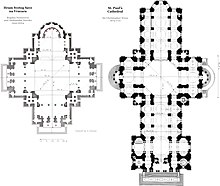Greek cross

The Greek cross , also common cross, is a cross with four sides of equal length that are at right angles to each other. Numerous other forms were derived from it ( Jerusalem cross , Wiederkreuz , Kruckenkreuz , Tatzenkreuz , Tolosanerkreuz, etc.). In a special context it is called the Balkenkreuz .
history
The Greek cross has been used in various contexts. A preliminary form is the Mithras cross from Iran, which was still used in the time of Emperor Constantine the Elder. Size was in circulation as a symbol of the Sol invictus (= undefeated sun). In Scandinavia it was the Christian symbol on picture and rune stones .
heraldry
The Greek cross comes u. a. in the national coat of arms of Greece , Malta and in the flag of Switzerland . From there it was adopted as a symbol of the Red Cross in honor of Henri Dunant's origins .
The cross can be modified as a common figure in heraldry , like the common cross. For example, in some historical forms of the Greek national coat of arms, the lengths of the vertical and horizontal cross arms are in a ratio of 7: 6 to each other.
architecture

In architecture the Greek cross plays an important role as a floor plan, it symbolizes the Christian faith. It is one of the oldest Christian symbols and the bars mean earth and sky or space and time. The first buildings were Byzantine and Syrian churches, in Europe large structures were built on the plan of the Greek cross, mostly as central structures . Churches designed as central buildings, especially those of the Christian East, often have the floor plan of a Greek cross, the motif was also taken up in the Renaissance, for example by Palladio in his Villa La Rotonda .
This cross shape was also used in atonement crosses , a characteristic of this is the low shape of the cross.
Individual evidence
- ↑ See Mithraism and Christianity as well as the related contribution to the discussion here .
- ↑ Monument typography: stone crosses. Atonement cross shapes on www.suehnekreuz.de (accessed on May 20, 2018).
literature
- Romuald Bauerreiß : The "sign of life". Studies on the early history of the Greek cross and the iconography of the early church portal (= publications of the Bavarian Benedictine Academy . Vol. 1, ZDB -ID 501875-4 ). Birkenverlag, Birkeneck near Freising 1961.

